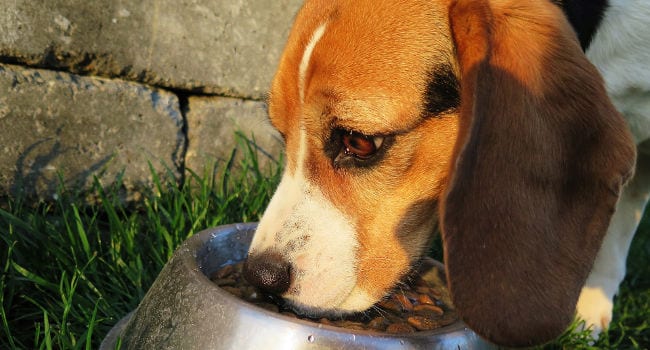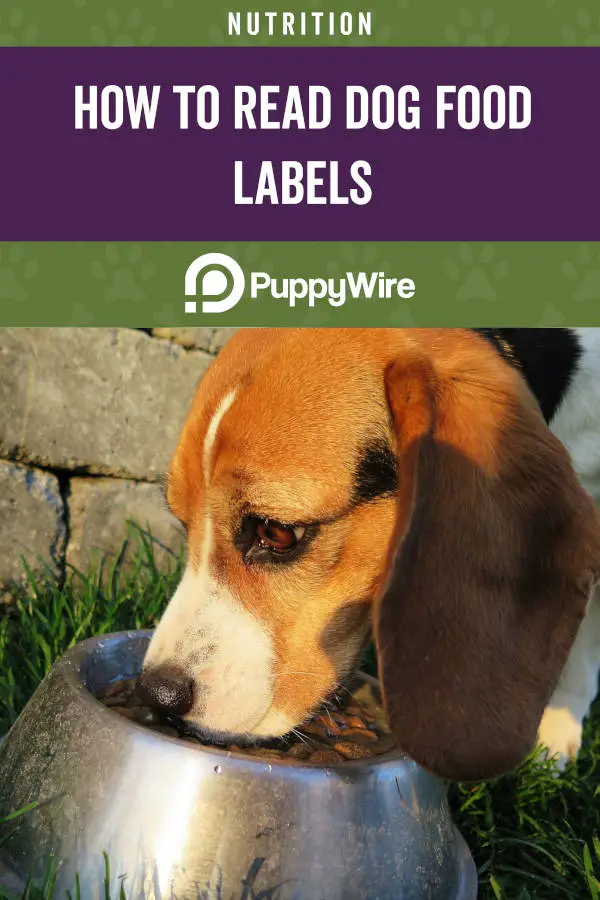How to Read Dog Food Labels and What to Avoid

Reading the label on dog food containers can be a little tricky. However, knowing how to read the labels and knowing what to look for is important to ensure that you are providing your pet with the best possible nutrition.
That’s why we have created this helpful guide that will enable you to better understand what the nutritional label on your dog’s food is telling you.
How to Read Dog Food Labels
The only real difference between food labels on human food and dog food is the ingredients. Dog food labels list the ingredients by weight, just like our food, and start with the heaviest ingredient.
Typically, the heaviest ingredient you will find on a dog food label will be meat. Just keep in mind, unless its meat meals, like bone, meat, or chicken meal, meat is 75 percent water.
Meals, however, are concentrated forms of meat with most water and fat being removed. This provides your pet with concentrated animal proteins.
What Does Holistic and Natural Actually Mean?
Just as marketing plays a large part in the brand and type of foods we buy for ourselves, so too does it play a role in the type of food we buy for our dogs. The terms “natural” and “holistic” are often used as a marketing method.
In fact, holistic, super-premium and premium are used as marketing tools and there are currently no regulations in place to control how they are used.
Other terms to watch out for are “made in a USDA-inspected facility” and claims of a dog food containing “human-grade ingredients.”
Human-grade food could simply mean that the food used to make the dog food was at one point in time safe for humans but has spoiled and used for the processing of pet foods instead.
Additionally, while the food could have been made in a USDA-inspected facility, that does not mean that the inspector was on site at the time of manufacture.
Organic Does Not Mean Better
Many dog food manufacturers label their products as “organic.” However, do not be fooled by this marketing ploy. While human organic food is regulated and usually better for you than non-organic foods, the dog food industry is different.
At the time of this writing, there is no regulation in place that oversees the use of the term “organic” when discussing dog foods. The good news is that the U.S. Department of Agriculture’s National Organic Program is currently reviewing this issue.
Guaranteed Analysis
While looking at the nutritional information on your pet’s food, you have more than likely noticed the percentages along the left side of the box.
This is the guarantee is mandatory and reflects how much of that specific ingredient is in each serving of your pets dog food. The labels also have to list the maximum percentage of moisture and fiber as well as the minimum amount of fat and protein.
As a general rule, 5.5 percent of your dog’s daily diet should be fat and at least 10 percent should be protein according to the National Research Council. Anything higher will more than likely go undigested by your pet.
Supplemental Dog Food
If you see a dog food labeled as supplemental, consult with your vet before you buy it for your dog. These types of dog foods do not provide pets with a balanced diet and are usually missing some key ingredients that your pet needs for a complete diet.
Meeting Your Dog’s Nutritional Needs

Probably the most important reason for reading food labels is to ensure that the food meets your dog’s nutritional needs. To help to make sure the brand you are using or thinking of using does just that, look for the statement of nutritional adequacy.
The majority of pet food makers adhere to regulations that have been established by the AAFCO, Association of American Feed Control Officials.
This organization has established what the minimum amount of nutrients should be in any dog food formulation. The regulation is designed to ensure our pets are receiving a complete diet.
Additional information on the label may include a statement that lets you know what life stage the food is best used for; puppies, adult, or senior. Since the nutritional needs of senior dogs can vary greatly, the AAFCO has not established any standards for this age group.
Preservatives, Stabilizers, and Artificial Colors
Ever look at a label and see all of those crazy names that look like they belong on the blackboard of a chemistry class? Those are the actual names of the preservatives, stabilizers, and artificial colors used when the dog food was processed.
All of these have to be listed by the manufacturer and approved by the FDA or be recognized as a safe additive. However, additives in ingredients of the food that have been processed in other locations, such as chicken or fish meal, does not usually get listed.
While additives with long scientific names are usually in this category, something as simple as high fructose corn syrup also is counted in this group.
Some synthetic preservatives have been under a great deal of debate about just how safe they are. Butylated hydroxyanisole, ethoxyquin, and butylated hydroxytoluene are used to keep fats in dog food from turning putrid and increase its shelf life to about 12 months.
Some consumers and even scientists have reported concerns about the safety of these three preservatives. However, the FDA maintains that the levels used in dog food are safe.
If ethoxyquin sounds familiar, it is because the manufacturer Monsanto Company conducted a test that resulted in liver damage in dogs that were fed foods with high amounts of the additive. The test was a result of consumer complaints of their dogs developing skin allergies, cancer, reproductive problems, and even organ failure.
In 1997, the FDA had dog food manufacturers cut the amount of ethoxyquin in their dog food products by 50 percent.
Some manufacturers are jumping on board with using natural preservatives, such as vitamin I and C, as well as various plant extracts in place of ethoxyquin, butylated hydroxyanisole, and butylated hydroxytoluene. The downfall of the natural preservatives is that they provide the dog food with a short shelf life.
Make sure that to check the label for a “best by” date before you feed your dog.
In the event you find that there are additives in your pet’s food that is not listed on the nutritional label, report it to the AAFCO. This is called “misbranding” and is prohibited under state and federal laws.
Misbranding prevents you from making an informed decision about what is the right food option for your dog.
Added Flavors
It’s no secret that many dog food makers add beef flavoring to their products to make the food have a meatier taste. However, foods with plenty of quality protein typically need no such additional flavors.
Make sure that you double check the protein level of your dog food if it contains additional flavors. It is possible that they manufacturer could be trying to cover up a product that is loaded with grains.
Byproducts in Dog Food
When speaking of the meat in dog food, the term “byproducts” include liver, bone, udders, cleaned intestines, stomachs, brains, and blood. However, it does not include teeth, hooves, hair, and horns.
While some amounts of the latter are acceptable and considered unavoidable, they do not fall into the by product category. Some byproducts, such as liver, are packed with nutrients and are actually a beneficial byproduct for your pet.
So, what does that mean? It means that just because a dog food might contain byproducts, it does not necessarily mean you should avoid that brand. Just make sure you know what the byproducts are.
Federal rules are in place to protect your pet from diseases such as mad cow disease. The FDA banned the use of any parts of animals that tested positive for the disease as well as certain parts from older animals since they are considered high risk.
Food Label Breakdown
All of the information that should be located on your pets food label is listed below. If you find that there is something missing, contact the AAFCO and avoid buying that brand. This information should be given on the food label as a minimum.
- Nutrient Guarantees
- Additives
- Ingredients
- Nutritional Adequacy
- Calories
- Feeding Directions
So, how do you find the best dog food available for your pet? It can be a challenge. The market is loaded with dog food brands that claim to be the best option for our pet.
However, by checking labels, knowing what’s inside the food, and understanding what your dog needs for nutrition, you can sort through all of the bad choices and find the right dog food for your Boxer (or any other dog breed…). Besides, there is no overall best dog food.
Each one of our four-legged friends has their own unique dietary needs and finding the perfect food for your pet will require checking labels and seeing what’s inside.
We hope this guide helps to simplify that process for you and leads you to the right choice for your pets.
